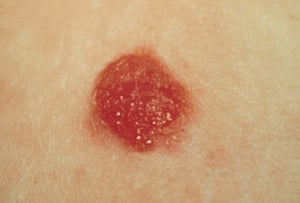Spitz lesion, juvenile melanoma, benign juvenile melanoma, or spindle and epithelioid cell nevus of Reed.
What is a Spitz nevus?
A Spitz nevus is a type of mole. Most people get moles during their life. A Spitz nevus can look a lot like a serious kind of skin cancer called melanoma. But it doesn’t cause damage to the body like a melanoma.
Most of the time there is only one mole and it is the common type. There are also more rare types. The more rare types are treated differently since they can be more like melanoma. There are many names for Spitz Nevi as listed above. This makes it confusing to look for more information on websites and in books.

How is it diagnosed?
- Surgery to remove all or part of the mole is done. This is called a biopsy.
- The skin is sent to the lab. A doctor who read biopsies, called a pathologist, will examine the skin. A pathologist who specializes in reading skin lesions is needed to make sure a Spitz nevus is not a melanoma. Sometimes the results are not certain.
- Spitz Nevi often looks just like other moles or skin lesions. Until the biopsy is done there is no other way to know for sure.
- Sometimes more tests are needed on the biopsy. Biopsies of lymph nodes in the same area of the body may be needed.
What is the treatment?
- Most often the nevus is removed at the same time the biopsy is done. Treatment will depend on the severity of the lesion. The doctor will talk with you about the different treatments.
- A yearly skin exam by a dermatologist is important if your child has had a Spitz nevus. More frequent exams may be needed depending on your child’s condition.
How can this type of skin lesion be prevented?
- Look at your child’s moles every month for any changes. Avoid the midday sun and sunburn. Use a sunscreen, hats and sun clothes that protect the skin.



